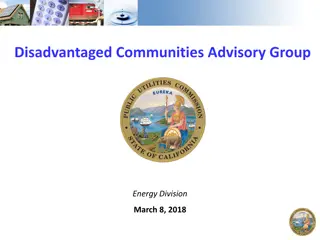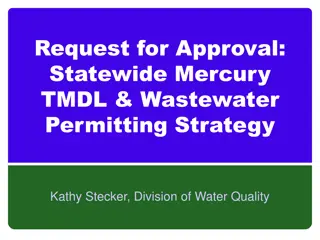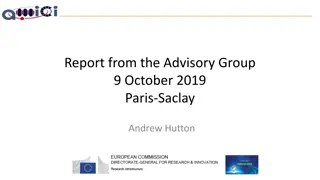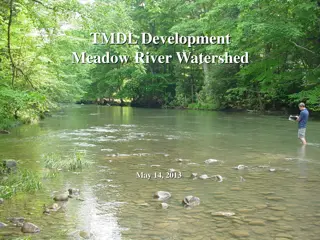Statewide TMDL Advisory Group Meeting - March 11, 2024
This Statewide TMDL Advisory Group meeting held on March 11, 2024, featured discussions on various topics including member introductions, water quality standards, TMDL prioritization framework, monitoring projects, nutrient standards, public comments, and upcoming meeting topics. STAG members from diverse affiliations participated, contributing to a comprehensive overview of water quality planning and assessment activities for the year.
Download Presentation

Please find below an Image/Link to download the presentation.
The content on the website is provided AS IS for your information and personal use only. It may not be sold, licensed, or shared on other websites without obtaining consent from the author.If you encounter any issues during the download, it is possible that the publisher has removed the file from their server.
You are allowed to download the files provided on this website for personal or commercial use, subject to the condition that they are used lawfully. All files are the property of their respective owners.
The content on the website is provided AS IS for your information and personal use only. It may not be sold, licensed, or shared on other websites without obtaining consent from the author.
E N D
Presentation Transcript
Statewide TMDL Advisory Group March 11, 2024
Welcome! This meeting is a webinar STAG members will be panelists Members of the public can raise their hand or use the Q&A feature to ask questions during the public comment portion of the meeting *9 raises your hand if you re on the phone State your name and affiliation before providing your comment 2
Water Quality Planning Bureau Bureau Chief Andy Ulven QA Manager Erin Louden Water Quality Standards & Modeling Katie Makarowski Monitoring & Assessment Darrin Kron Nonpoint Source & Wetlands Hannah Riedl TMDLs Christina Staten 3
STAG Roll Call Representing STAG Member & Affiliation Term End Date Karli Johnson Montana Farm Bureau Farming-Oriented Agriculture January 31, 2026 Ellie Brighton Montana Stockgrowers Association Livestock-Oriented Agriculture January 31, 2026 Frank Szollosi Montana Wildlife Federation Conservation or Environmental Interest January 31, 2026 David Brooks Montana Trout Unlimited Water-Based Recreation January 31, 2026 Brian Sugden Sugden Forest Environmental, LLC Forestry Industry January 31, 2026 Ryan Leland City of Helena Municipalities January 31, 2026 Brian Heaston City of Bozeman Point Source Dischargers January 31, 2026 Greg Bryce Hydrometrics Mining January 31, 2026 Vacant Federal Land Management Agencies Jeff Schmalenberg Dept. of Natural Resources & Conservation State Trust Land Management Agencies January 31, 2026 Vacant (Substitute: Becca Boslough) Montana Association of Conservation Districts Conservation District Supervisor East Vacant (Substitute: Becca Boslough) Montana Association of Conservation Districts Conservation District Supervisor West Jordan Tollefson Northwestern Energy Hydroelectric Industry January 31, 2026 4 Mike Bias Fishing Outfitters Association of Montana Fishing-Related Business January 31, 2026
Agenda STAG Overview Member Roles and Responsibilities Discussion of STAG Chair Position TMDL Prioritization Framework and TMDL Priority Areas Overview of TMDLs and Prioritization Framework Current and Planned TMDL Priority Areas Water Quality Monitoring & Assessment Activities 2024 Water Quality Monitoring Projects Water Quality Integrated Report Update Assessment Methods Development & Comment Opportunities Update on Nutrient Water Quality Standards Status of SB358 Rulemaking to Interpret Narrative Standards and Develop an Adaptive Management Program Public Comment & Close of Meeting Discussion of Next Meeting Topics and Meeting Date Public Comment As Time Allows: Nonpoint Source & Wetlands Program Updates Call for Applications Alternative Restoration Plans 5
Statewide TMDL Advisory Group Overview - Christina Staten, TMDL Section Supervisor 6
STAG Advisory Role Authorized under 75-5-702(10), MCA Comprised of 14 members representing broad base of water-related interests Members are appointed by DEQ Director Does not have officers, require quorums, or have decision-making authority Members serve in advisory capacity to the department on topics such as: TMDL development priorities Water quality assessment methods TMDL implementation monitoring Because of the STAG s diversity in representation of interest groups across Montana, it can play an important role in formulating Montana s water quality policy 7
Member Responsibilities You are representing an interest group in Montana Attend meetings twice a year Renewable two-year term limit (solicitations occur at term end dates) Notify the department if you re stepping down from your position 8
STAG Chair Discussion Informal Meeting facilitation assistance Agenda feedback 9
TMDL Overview - Christina Staten, TMDL Section Supervisor 10
Total Maximum Daily Loads (TMDLs) Math and the path Pollution budget or diet for a waterbody TMDLs are developed for each waterbody-pollutant impairment identified on the impaired waters list 11
Benefits of TMDLs Incorporate multiple source types, both regulated and non-regulated Address cumulative impacts Guide future restoration work and prioritization of projects Help the local community and landowners identify the best ways to protect water quality 12
TMDL Priority Areas - Christina Staten, TMDL Section Supervisor 13
TMDL Section Staff 5 TMDL Planners Heather Henry Troy Clift Lisa Anderson Kylie Bodle 1 planner in hiring process Heather Kyle 1 Adaptive Management Program Scientist Kyle Milke Lisa Troy 14
2023-2024 TMDL Priorities Bridge Metric: Bitterroot River Nutrient Protection Plan (completion) Beaverhead Watershed Nutrient TMDLs (development) Red Rock Watershed Nutrient TMDLs (development) Ashley Creek (Flathead-Stillwater) Nutrient & Sediment Addendum (development) 15
Draft TMDL Priorities Beyond 2024 (Vision 2.0) Upper Gallatin - excess algae Smith River - nutrients Upper Missouri River - nutrients, metals Clarks Fork Yellowstone River TMDL revisions and consideration of ARPs in tandem w/AMP 16
STAG Feedback / Discussion 18
TMDL Prioritization Framework - Christina Staten, TMDL Section Supervisor 19
Vision 2.0 Prioritization Approach Watershed scale approach by TMDL planning areas State law prioritization factors (75-5-702, MCA) New individual MPDES permit applications Adaptive Management Plan (AMP) considerations STAG input 20
TMDL Prioritization Factors New, individual discharge permit application TMDL implementation considerations Program coordination Resource value Potential impact to use (human health and aquatic life) Impairment characteristics (severity and magnitude) Court determinations General waterbody characteristics (size, importance) Per 75-5-702, MCA, DEQ must consult with the STAG when prioritizing waters for TMDL development 21
AMP Considerations TMDL development or revision may be coordinated with active AMPs, to the extent possible TMDL revision will be prioritized when data collected by a permittee indicate a different nutrient target is more appropriate For watersheds without existing nutrient TMDLs, AMPs may be submitted to EPA as advance restoration plans. Acceptance by EPA may prompt DEQ to lower the TMDL priority ranking. TMDL revisions and ARP development will still be prioritized in accordance with 75-5-702, MCA, and in consultation with the STAG 22
Addressing Environmental Justice and Climate Change Required for Vision 2.0 framework Not inherently part of Montana s priority factors EJ addressed by: Collaborating with tribal governments Traveling to local watershed for meetings Accommodating ranching/farming needs when scheduling meetings 23
Addressing Climate Change Prioritizing watersheds more vulnerable to increased stream temperatures (excess algae listings) Developing protection plans for areas susceptible to impairment Addressing HABs when developing lake TMDLs for eutrophication Evaluating future flow conditions as part of source assessment for pollutants tied to flow TMDL implementation: recommending and funding floodplain and water storage improvement projects 24
STAG Feedback / Discussion 25
Water Quality Monitoring & Assessment Activities for 2024 - Darrin Kron, Monitoring & Assessment Section Supervisor 26
Water Quality Monitoring & Assessment Activities Darrin Kron, Water Quality Monitoring and Assessment Section Supervisor Gallatin River Assessment Request Under provision 75-5-702(3) Excessive Algae Growth Impairment Addended 2020 IR Next IR Submittal will be combined 2022/2024 Call for data and assessment work Data organization and partial analysis Delayed by implementation of narrative nutrient standards and implementing more pollutant assessment methods 27
Water Quality Monitoring & Assessment Activities Ongoing Monitoring or 303d Assessment Projects: Yellowstone River Upper Missouri River Smith River South Fork Judith Upper Gallatin Gallatin Focus Area Bitterroot Focus Area Clark Fork River Volunteer Monitoring Support Program Big Spring Creek Clark Canyon Reservoir Lake Mary Ronan Rattlesnake Creek Kennedy Creek Goat Creek Lake Koocanusa/Kootenai River PFAS Statewide Clarks Fork of Yellowstone 28
Water Quality Monitoring & Assessment Activities Assessment Method Development: Phase I Spring 2024 Dissolved Oxygen All waters pH All waters Ammonia All waters Temperature Streams/Rivers Phase II With 2022/24 IR Wadable Stream Nutrient Assessment Method Update - to coincide or follow SB358 rules Lake and Reservoir Eutrophication (Algae, HABs, Nutrients) Large River Eutrophication (Algae, Nutrients) Use of Fish Tissue Toxics Data (Mercury, PCBs, Dioxins) 29
Update on Nutrient Water Quality Standards - Katie Makarowski, Water Quality Standards & Modeling Section Supervisor 30
Transition to Narrative Nutrient Standards Senate Bill 358 (2021) required DEQ to: Adopt rules related to narrative nutrient standards Delete references to numeric nutrient standards Develop an Adaptive Management Program (incremental watershed approach to protecting water quality). Consultation with Nutrient Work Group 45 meetings since August 2020 40 since SB 358 signed into law in April 2021 31
Narrative Nutrient Rulemaking New Rule I - TRANSLATION OF NARRATIVE NUTRIENT STANDARDS Translators identify causal and response variables and thresholds to protect beneficial uses; used to determine if narrative nutrient standard is met New Rule II - IMPLEMENTATION OF THE ADAPTIVE MANAGEMENT PROGRAM FOR NARRATIVE NUTRIENT STANDARDS New, optional compliance approach implemented within MPDES permitting program to address nutrient sources in watersheds Circular DEQ-15 Amend and repeal related rules 32
Rulemaking Timeline 2021 to 2024 - Conceptual review and initial drafting; Consultation with Nutrient Work Group March 8, 2024 Revised rule package to NWG and WPCAC *dates subject to change March 15, 2024 - Rulemaking update to WPCAC March 18, 2024 - Rulemaking overview to WPIC April 16, 2024 - File proposal notice with SOS April 26, 2024 - Proposal notice published in MAR April 26 June 10, 2024 - Public comment period NWG = Nutrient Work Group June 10, 2024 - Public hearing WPCAC = Water Pollution Control Advisory Council Respond to comments; modify adoption notice WPIC = Water Policy Interim Committee September 24, 2024 - File adoption notice with SOS SOS = Secretary of State October 4, 2024 - Adoption notice published in MAR MAR = Montana Administrative Record Submit to EPA 33
Nonpoint Source & Wetlands Program Hannah Riedl Funding available now! Apply by April 5th, 2024 Planning and project implementation Capacity building* and education and outreach 34
Alternative Watershed Restoration Plans a. When the impairment is not specific to a pollutant. b. When responding to a NPS pollution emergency or urgent NPS public health risk. c. When protecting assessed unimpaired/high quality waters. d. When addressing an isolated, small-scale water quality problem resulting from one or a few sources of pollution. 36
Nine-element Watershed Restoration Plans Alternative Watershed Restoration Plans 1. Identification of causes of impairment and sources of pollution. 1. Identification of causes of impairment and sources of pollution. 2. An estimate of the pollutant load reductions needed to achieve water 2. An estimate of the pollutant load reductions needed to achieve water quality standard quality standard 3. A description of the nonpoint source management measures needed to 3. A description of the nonpoint source management measures needed to achieve pollutant load reductions. achieve pollutant load reductions. 4. An estimate of the technical and financial assistance needed to implement 4. An estimate of the technical and financial assistance needed to implement the management measures. the management measures. 5. An education and outreach component to encourage public participation in 5. An education and outreach component to encourage public participation in designing and implementing the management measures. designing and implementing the management measures. 6. A reasonable schedule for implementing the management measures. 6. A reasonable schedule for implementing the management measures. 7. Milestones to gauge progress in implementing the management measures. 7. Milestones to gauge progress in implementing the management measures. 8. Criteria for determining to what extent management measures are reducing 8. Criteria for determining to what extent management measures are reducing pollutant loads and improving water quality over time. pollutant loads and improving water quality over time. 9. A monitoring plan for collecting the data necessary to evaluate 9. A monitoring plan for collecting the data necessary to evaluate improvements based on the criteria above. improvements based on the criteria above. 37
Close of Meeting Discussion of Next Meeting Topics and Meeting Date Public Comment 38
Questions/ Comments Raise hand (*9 if on the phone) or type questions into the Q&A DEQ will unmute you if you wish to provide your comment orally If calling by phone, press*6 to unmute State your name and affiliation before providing your comment 39
Thanks for Joining Us Contact: Christina Staten, CStaten@mt.gov https://deq.mt.gov/water/councils 40























